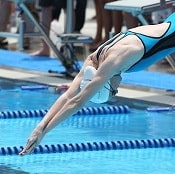In swimming, the flutter kick occurs with the backstroke and freestyle strokes. It’s a simple kick that’s easy to learn and is one of the first kicks taught to swimmers when learning to swim.
However, just because it’s simple and easy to learn doesn’t mean that it’s without its challenges for some swimmers. Especially when trying to flutter kick correctly.
Related article: Beginner’s Guide to Swimming Freestyle
Here’s how to flutter kick in freestyle (or front crawl) along with some mistakes to avoid and more information about kicking patterns than you ever wanted to know 🙂
Disclosure: This post may contain affiliate links, meaning we earn a small commission at no cost to you if you purchase something through one of our links. As an Amazon Associate, we earn from qualifying purchases. Please check out our disclosure page for more information

Why Should You Kick When You Swim?
When you struggle with kicking when swimming, it’s tempting to avoid it altogether. And while you can, learning to properly kick can make your swimming much easier. At the same time, you can also go faster with a strong kick!
Kicking while you swim has the obvious benefit of helping you move forward in the water. Adding propulsion to your stroke, which is already pulling you through the water.
Related article: 11 Ways to Improve Your Flutter Kick
And if done correctly, the kick helps tie into the stroke. Your hips (and therefore your legs) help provide the rotation needed for a stabilized stroke while at the same time, driving the kick.
Because of this, the flutter kick helps to balance your body as a whole. This can happen whether you kick constantly or have a slow beat kick (more on that later).
You’ll find that your body doesn’t rock too much if you have a good kick. Just as you don’t swim flat in the water without rotation.
How to Flutter Kick in Freestyle (or Front Crawl)
The flutter kick in freestyle consists of the legs moving horizontally through the water and in an up-down motion that’s opposite of each other. So that as one leg moves up, the other moves down.
Sounds simple, right? 😉
Let’s break it down just a bit more.
Downward Kick
As stated earlier, the flutter kick works when one leg moves up and the other moves down.
The downward motion starts with the core and hips, never the knee! Starting and continuing your kick from your core and hips will carry the motion down through your leg, where you can feel it in your thighs.
A common mistake is to bend at the hips and bring the knees down to start the kick. Almost like trying to ride a bike. Instead, you’ll want to keep your leg straight out behind you as you kick down.
Related article: 8 Flutter Kick Drills
Truthfully, as your leg is kicking down through the water, your knee straightens out completely while your ankle is flexing down. Your knee will end up locking at the very end of the downward kick.
As you’re kicking down with your leg, you’ll want to flex your ankles. Keeping your ankles relaxed will help you flex them easier. In some ways, it’ll look as though you’re trying to point your toes some, even if you’re not purposely pointing them.
While your leg is pressing down through the water, you’re pushing water at the same time. In turn, this is helping to create the propulsion and movement that will help drive you forward.
The Upward Kick Motion
After the downward motion of your kick, your leg will need to move back up to complete the kicking motion.
This is the upward part of the kick and while it doesn’t necessarily move you forward, it is necessary to help your hips rotate. And complete the kick, of course!
At this point of the kick, your knee will bend just enough to flex your leg back up to the surface of the water. Let the knee bend naturally, almost like you’re walking. It shouldn’t bend so much that your lower leg is coming out of the water.
Instead, only part of the foot should come out of the water. Some swimmers can get their heels and toes out of the water based on how much they can flex their feet. But getting only your heel out will be enough 🙂
Related article: How to Side Breathe When Swimming Freestyle
Putting the Flutter Kick Together
To put the flutter kick together, you’ll want to ensure that your legs are moving opposite of each other. As one leg is kicking down, your other leg should be moving up.
It will make a constant cycle that starts from your core and moves down through your hips to your toes as you kick down.
You’ll want to ensure that you’re keeping your kick short (or shallow) so it’s a fast motion with your legs. If you do long and deep kicks, you’ll struggle with balance and you won’t go very far.
Lastly, be sure to get some hip rotation as you’re kicking. You don’t want to keep your hips flat and still when flutter kicking. Instead, they should be rolling slightly with each movement of the kick.
Your hips should be rotating down towards the bottom of the pool on the upward part of your kick. And then rotating back up when you’re kicking down.
Kicking Styles
A kicking pattern is the number of kicks you take within each stroke cycle.
Kicking patterns vary by swimmer and there’s no right answer as to which you should use. Instead, find what feels more comfortable for you.
Related article: Why is Swimming so Hard?
When you’re learning how to flutter kick in freestyle, we don’t believe that it’s overly important to focus on one kicking style over the other. Instead, it’s more important to develop a proper kick before finding the kicking pattern that works for you.
There are several different kicking rhythms that swimmers use. From the two-beat kick to the six and eight-beat kick. Each has its pros and cons.
Two-Beat Flutter Kick
You see this kicking pattern frequently used with distance swimmers, as it uses less energy compared to a six or eight-beat kick.
As the name implies, you take two kicks within one stroke cycle (note that a cycle is when you take two strokes, such as a left stroke and then a right stroke). Some swimmers will kick with each stroke they take.
It’s not a constant kick and there will be a pause between each kicking motion. And for some swimmers, it’ll almost look as though there’s no kick at all. Or that the legs are dragging behind the swimmer.
More Content for You: 8 Best Swim Bags for Swimmers
Six-Beat Flutter Kick
Conversely, a six-beat kick looks almost like a continuous kick. Because of this, it can be referred to as ‘continuous kicking’. This is my preferred kicking pattern 🙂
The six-beat kick can be harder to maintain the kicking speed for long distances. This is why it’s typically used by sprinters and short to mid-distance swimmers. Or at the end of a longer race.
However, you can also see distance swimmers utilizing a six-beat kick. It just may not be as strong or fast compared to a kick at a shorter distance.
During a six-beat kicking pattern, you’ll kick six times during a stroke cycle. This will equal out to each leg kicking three times each by the time you complete a full cycle.
More Content for You: 8 Best Swim Parkas for Swimmers
Some swimmers stress about this kick and try to count the number of kicks per stroke. Instead, we recommend that you just focus instead on kicking while taking your strokes. You’ll end up naturally doing six kicks within your stroke without realizing it.
3 Common Flutter Kick Mistakes
While the flutter kick in freestyle is simple in theory, it’s just as easy to make mistakes. Below, we’ll cover a few of the more common mistakes you can make doing the flutter kick and how to correct them.
Knee Kicking
Probably the biggest and most common mistake we see in the flutter kick is excessive knee kicking. While your knee does bend on the upward motion of the kick, it’s a very minimal bend.
If any part of your lower leg (from the knee down) is coming out of the water, you’re bending your knee too much. When you’re kicking this way, the only thing you’ll accomplish is a super splashy kick that doesn’t get you very far.
Instead, work your flutter kick so that only the heel of your foot is leaving the water. Or at most, your foot.
You can work on correcting this by kicking with a pull buoy, which should make it more difficult to bend your knees. It’ll also keep you from taking big, deep kicks (covered next).
More Content for You: How Many Laps is a Good Swim Workout?
Too Deep of a Kick
When flutter kicking while swimming, your kick should be short and shallow. Not big, deep, and sweeping kicks. You waste energy, effort, and time trying to kick with deep kicks. And it’s absolutely exhausting.
Instead, keep your kicks short and narrow. At best, we would say that you shouldn’t be going much deeper than a foot under the water with your kick. This is especially true if you have a 6-8 beat kick. For these kick patterns, your kick is probably shallower than that of a 2 beat kick.
If you duck your head under the water while swimming, look down at your feet. You should see your feet just barely pushing down under the water’s surface. If they’re going down low enough that you can see more of your shins, then it’s too deep.
Bicycle Kicking
Probably one of my biggest pet peeves when teaching swimming and one of the second most common mistakes in the flutter kick. Bicycle kicking creates a massive amount of resistance (or drag) when you’re swimming and you go nowhere.
It’s tempting and easy for swimmers to want to pull their knees up to their chest in an attempt to kick and then push them back out. Almost like peddling a bike. This comes from the easy-to-learn doggy paddle that almost all of us learned as kids.
More Content for You: Ultimate Guide to Women’s Swimwear
However, it’s terrible technique and admittedly, it can be difficult to unlearn.
Remember that in the flutter kick in freestyle, your legs stay out behind you. At no time do you bend at the waist and bring your knees up to your hips/chest.
Practice your flutter kick on the wall where you don’t have to focus on your freestyle stroke. Watch your kick underwater and see if you’re bringing your knees up instead of keeping your legs behind you.
You may need to do some kicking with a smaller pull buoy to help keep your legs out behind you. Adding fins can also help straighten your legs out, as the natural resistance and weight that fins add make it more difficult to bring your legs up.
In Closing
When done correctly, the flutter kick in freestyle is effortless and dare we say, fun! We encourage you to keep practicing your kick at each of your workouts. Mix in kick sets where you just kick instead of swimming to get dedicated kicking practice.
Once you get the hang of it, you’ll be surprised at how fast you can go!
As always, happy swimming.
Chevron
Bonus Content
The 7 Best Swim Shampoos to Remove Chlorine: The chemicals in the pool can leave your hair crunchy and straw-like. Here are the best swim shampoos to help reverse chlorine damage.
Basic Swimming Terminology: Knowing some swimming terminology, or swim terms, will help you navigate the swimming world. Here are 25 common swimming terms to get you started.

Want to Improve at the Pool?
Join swimmers and swim parents to receive my free newsletter and receive a free Swimming Glossary e-book as a thanks!
Every month you’ll receive tips and coaching to help you find success at the pool.
About

Chevron is a current competitive swimmer with almost 20 years of experience in the pool. And although she fell into the sport by accident in her high school years, she still trains daily and competes throughout the year. She’s committed to providing guidance to all levels of swimmers and believes that everyone should know how to swim.